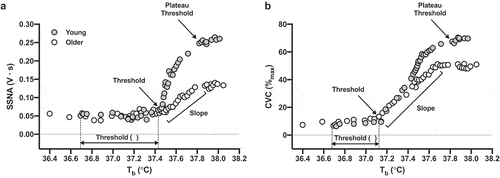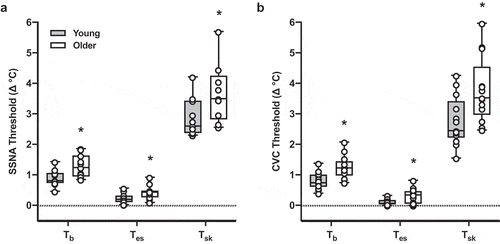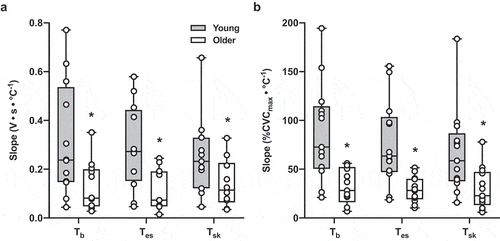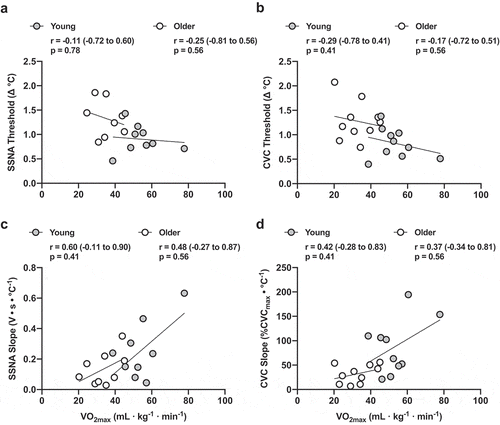Figures & data
Table 1. Participant characteristics
Figure 1. Representative data illustrating the profile of skin sympathetic nervous system activity (SSNA; Panel A) and cutaneous vascular conductance (CVC; Panel B) in response to whole-body passive heating-induced increases in mean body temperature (b) in one young (gray symbols) and one older adult (white symbols). The threshold was defined as the
b at which activation of SSNA and the initiation of reflex cutaneous vasodilation first occurred. The slope of the linear portion of the relation between
b and SSNA or CVC (demarcated by the threshold and the
b at which the response plateaued) was calculated by linear regression and used as an index of the thermosensitivity of the reflex response

Table 2. Thermoneutral baseline and absolute onset threshold temperatures
Figure 2. The increase in mean body temperature (b; n = 12 young, n = 11 older), esophageal temperature (Tes; n = 11 young, n = 9 older), and mean skin temperature (
sk; n = 12 young, n = 11 older) required for activation of skin sympathetic nervous system activity (SSNA; Panel A) in young (gray bars) and older adults (white bars). In individuals in whom the threshold for SSNA could not be determined, data were excluded from analysis. The initiation of reflex cutaneous vasodilation is presented in Panel B (n = 13 young, n = 13 older). Mean summary data are presented as the median, first and third quartiles, and range (minimum and maximum), and group differences were analyzed by unpaired t-test. The
b onset threshold for both SSNA and cutaneous vascular conductance (CVC) was greater in older adults. *p < 0.05 vs. young

Figure 3. The slope of the linear portion of the relation between skin sympathetic nervous system activity (SSNA; Panel A) and cutaneous vascular conductance (CVC; Panel B) and increases in mean body temperature (b; n = 12 young, n = 11 older), esophageal temperature (Tes; n = 11 young, n = 9 older), and mean skin temperature (
sk; n = 12 young, n = 11 older) during passive heating in young (gray bars) and older adults (white bars). Mean summary data are presented as the median, first and third quartiles, and range (minimum and maximum), and group differences were analyzed by unpaired t-test. In individuals in whom the slope for SSNA could not be determined, data were excluded from analysis. The sensitivity of both SSNA and vasodilatory responsiveness was markedly reduced in older adults. *p < 0.05 vs. young

Figure 4. The correlation (95% confidence interval) between maximal oxygen consumption (VO2max) and the relative mean body temperature (b) threshold for skin sympathetic nervous system activity (SSNA; n = 9 young, n = 8 older; Panel A) and reflex cutaneous vasodilation (n = 10 young, n = 10 older; Panel B) during passive heating in young (gray symbols) and older adults (white symbols). The relation between VO2max and the sensitivity of SSNA and vasodilatory responsiveness are presented in Panels C and D

